Snowmobile Guide for the Columbia and Rocky Mountains
of British Columbia
Introduction
British Columbia’s natural splendor and biological
diversity serves as a backdrop to a host of world class
outdoor recreation opportunities. As a result, B.C. attracts
visitors from around the globe, and ecotourism and adventure
travel are among the fastest growing components of the
B.C. tourism sector. B.C.’s backcountry is used by
a variety of outdoor enthusiasts, and cooperation between
user groups is necessary to ensure positive and safe
backcountry experiences for all users.
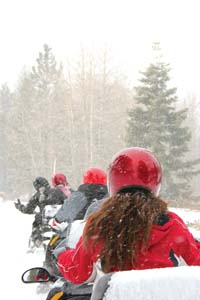 Legal
and voluntary agreements have been developed in many
parts of B.C. to try to ensure that all users - motorized,
non-motorized, commercial and non-commercial have a
winter experience that is both safe and memorable. They
have also been designed to address environmental issues
such as wintering wildlife and water quality. Legal
and voluntary agreements have been developed in many
parts of B.C. to try to ensure that all users - motorized,
non-motorized, commercial and non-commercial have a
winter experience that is both safe and memorable. They
have also been designed to address environmental issues
such as wintering wildlife and water quality.
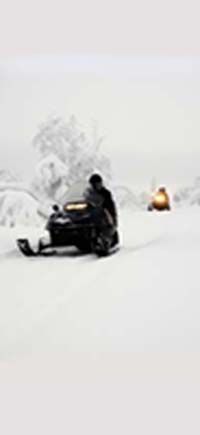 In many regions of British Columbia, many representatives
of the snowmobile community have worked for years with
other outdoor recreation sectors and government to reach
balanced recreation land use agreements that respect
the need to provide quality recreational experiences
to a diverse range of backcountry users. Many hundreds
of hours of volunteer efforts have gone into these processes,
and by respecting and obeying these agreements we maintain
and enhance sensitive ecosystems, protect our continued
access to large areas of a B.C.’s beautiful backcountry,
avoid more restrictive regulation, and demonstrate to
other users that we respect their right to enjoy the
backcountry.
In many regions of British Columbia, many representatives
of the snowmobile community have worked for years with
other outdoor recreation sectors and government to reach
balanced recreation land use agreements that respect
the need to provide quality recreational experiences
to a diverse range of backcountry users. Many hundreds
of hours of volunteer efforts have gone into these processes,
and by respecting and obeying these agreements we maintain
and enhance sensitive ecosystems, protect our continued
access to large areas of a B.C.’s beautiful backcountry,
avoid more restrictive regulation, and demonstrate to
other users that we respect their right to enjoy the
backcountry.
Snowmobile Areas for the Columbia and
Rocky Mountains of British Columbia
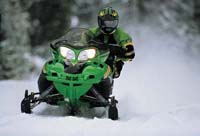
It is your responsibility to be familiar
with the winter activities allowed in various parts
of the area before you visit. Please obey and respect
closed areas. Failure to comply and cooperate can lead
to fines, equipment seizures, and ultimately closure
of areas to everyone. Every snowmobile rider must be
an ambassador for the sport. Please give careful consideration
to your effect on the trails, environment and others.
The future of snowmobiling depends on it.
Backcountry Experience
Although various backcountry activities are occurring
on the landscape at the same time, each user group values
and expects very different backcountry experiences.
Sledders may enjoy covering ground with groups of friends,
whereas, skiers may enjoy winter solitude on their own
or with small groups. Communicating experiential preferences
with other user groups will result in better understandings
and relationships between all backcountry users and
provide safe, accessible, and sustainable backcountry
recreation opportunities
Backcountry recreation is important to local economies
in British Columbia as it provides jobs, increases tourism
and business, and provides tax revenues. If backcountry
users have quality experiences, they will continually
recreate in B.C.’s backcountry, whether they are
local residents or tourists. However, if backcountry
users are dissatisfied with their experience, they will
no longer participate in backcountry recreation and
B.C.’s backcountry business.
Backcountry Etiquette
British Columbia provides many opportunities for backcountry
recreationalists, and if all users do not cooperate
and work together, recreationalists can impact sensitive
ecosystems, disturb wildlife, and disrupt other commercial
or public recreation users. Winter safety is a critical
issue for all of us, and separating backcountry activities
in time and geography may reduce risks for all users.

User Conduct
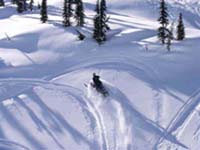 Commercial,
as well as recreational backcountry activities such
as heli-skiing, cat-skiing, ski-touring, snowshoeing
and cross-country skiing are taking place in the same
mountain locations as snowmobiling.
Commercial,
as well as recreational backcountry activities such
as heli-skiing, cat-skiing, ski-touring, snowshoeing
and cross-country skiing are taking place in the same
mountain locations as snowmobiling.
- Before visiting an area, check for any commercial
tenures in the area that may be affected by your presence
and vice versa
- If you find yourself in the same locale as other
backcountry users, communicate with them and compare
routes and safety concerns. By identifying areas that
could be of possible conflict ahead of time, conflict
can be avoided
- watch for their tracks and avoid these areas when
sledding
- avoid endangering yourself or others by avoiding
high-risk activities such as high marking in avalanche
prone areas that are being used by other backcountry
users
- avoid using the same trails and roads at the same
time as other backcountry users
- actively seek out local recreation maps for the
area you will be visiting
- respect and protect all local land use signage
- avoid entering designated non-motorized areas
- avoid helicopter landing areas
- respect other users and help them when in need
- educate other sledders of the importance of supporting
land use agreements.

Safe Sledding
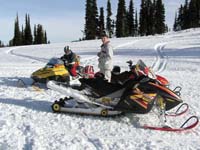
- Zero tolerance with respect to
impaired riding. Alcohol magnifies and distorts challenges
and can quickly turn an enjoyable outing into a situation
that's hazardous for you and others. Alcohol and snowmobiling
simply do not mix.
- Know your abilities and don't
go beyond them; know your machine's capabilities and
don't push beyond them. Know your riding area. Get
a map. You should always ride at a speed in which
you can stop within your line of sight.
- Follow the rules: Regulations
on sled registration and use are different in various
areas. Check with natural resource and law enforcement
agencies, and snowmobile dealers or clubs in the area
to make sure your ride results in legal and hassle-free
snowmobiling.
- Think ahead: A safe rider makes
snowmobiling safe. Use common sense. Minor problems
can be overcome by carrying a useful tool kit, spare
parts, flashlight, first-aid kit and a few survival
items such as high-energy food, fire-starting equipment
and a compass.
- Dress appropriately: Make sure
your helmet is safety-certified, the right size and
in good condition. Wear layers of clothing, so that
you can add or remove layers to match changing conditions.
- Beware of water: The safest snowmobiling
rule is never to cross lakes or rivers. Besides the
danger of plunging through the ice, you have far less
traction for starting, turning and stopping on ice
than on snow. You are responsible for your own safe
snowmobiling.
- Mountain Measures: Mountain snowmobiling
can pose extra dangers, such as avalanches. Some avalanche
areas may be posted and closed. Be cautious of avalanche
dangers throughout mountain country. Riding in these
areas should only be done after receiving mountain
riding training. Mountain snowmobilers should carry
avalanche beacons, shovels, and probe poles for locating
people buried in snow and a portable radio to summon
help.
- Avalanche Safety: Sledders in backcountry areas should be aware of current avalanche conditions
and familiar with the use of avalanche safety equipment. For more information about current avalanche conditions, equipment,
and training courses, please visits the Canadian Avalanche Association at http://www.avalanche.ca/

Mountain Caribou
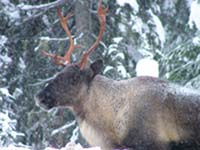 Mountain Caribou are an ecotype of British Columbia's woodland caribou population. They are globally unique, as they are the
world's southernmost caribou population and the only remaining caribou that live in rugged-mountainous terrain feeding on arboreal lichens in winter.
They no longer live in almost half of their original range and scientists believe that the population has declined because of habitat
fragmentation, increased predators, backcountry recreation, and climate change. Currently, this population is listed on Schedule 1 of the
Species at Risk Act (SARA) as Threatened.
Mountain Caribou are an ecotype of British Columbia's woodland caribou population. They are globally unique, as they are the
world's southernmost caribou population and the only remaining caribou that live in rugged-mountainous terrain feeding on arboreal lichens in winter.
They no longer live in almost half of their original range and scientists believe that the population has declined because of habitat
fragmentation, increased predators, backcountry recreation, and climate change. Currently, this population is listed on Schedule 1 of the
Species at Risk Act (SARA) as Threatened.
The high country of B.C.’s Interior Wet Belt provides
treed areas amongst large open areas, which are ideal
for Mountain Caribou as well as various types of snowmobiling
and backcountry recreation.
The presence of snowmobilers affects Mountain Caribou,
as it may cause caribou to move into less suitable habitat
where foraging is not as efficient or where steeper
terrain may cause avalanche hazards. The unnecessary
movement of caribou may also deplete their energy reserves
during critical times. Packed trails may provide easier
access for predators to move into caribou areas. For
more information on snowmobiling and caribou in B.C.,
please see “Snowmobiling and Caribou in British
Columbia” located at http://www.env.gov.bc.ca/wld/twg/related.html
Wildlife
- Keep your distance/avoid and do not disturb wildlife
- Respect the animals and their habitat, do not approach
them or follow tracks. If you come upon animals, shut
your machine down until they leave the area
Riding Areas
- Stay safe and legal within the areas that you are
permitted to ride or those for which you have obtained
permission
- There are lots of opportunity areas to ride so avoid
areas that are marked as environmentally sensitive,
protected, or off limits to snowmobiles. Obey and
do not move, remove, or destroy information signs

Reducing Impacts
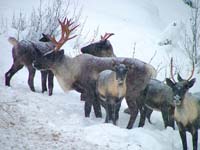
- Know before you go! Identify whether your riding
area is within caribou habitat
- Identify snowmobile closure areas. Details and
maps regarding local closures are in the Hunting and
Trapping Synopsis, which can be obtained free at many
sporting goods stores and on the web at: http://www.env.gov.bc.ca/fw/wild/synopsis.htm
- Ride only in areas designated for snowmobiling;
do not ride in closed areas
- If caribou tracks are observed, do not follow the
tracks
- If caribou are encountered, turn off engine and
wait until they have moved. Then, leave the area and
refrain from riding within sight of caribou
- Do not approach caribou and stay as far away as
possible from caribou as safely as possible
A Snowmobilers Guide to Environmental Stewardship in B.C.
- Take care of trails
- Respect trails
- Respect other users of trails
- Avoid damaging vegetation by riding only where snow is greater than 30 cm deep
- Do not approach, follow, or harm any wildlife
- Leave tracks not trash
- Bring out everything you bring in
For more information contact:
Ministry of Environment
Environmental Stewardship Division
Prince George, B.C.
(250) 614-9910
|